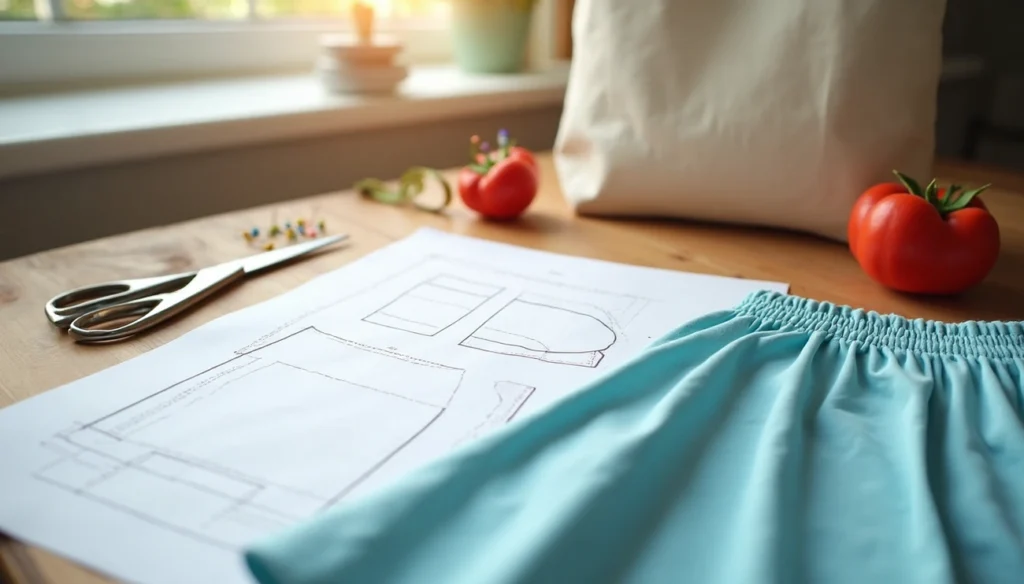Yes, Sewing patterns can be easy if you start with beginner-friendly designs like simple skirts, shirts, or accessories. A competent beginner can achieve decent results after a few attempts. Pattern difficulty depends on design complexity and experience, so starting simple increases success.
Are Sewing Patterns Really Easy?
Yes, sewing patterns is easy to learn for beginners. Let’s examine what truly constitutes a beginner-friendly pattern and why some designs cause frustration.
What are the easiest sewing patterns for beginners?
If you’re a beginner then you’ll try simple shapes, minimal pieces, no complex closures, and straightforward instructions. Like: Elasticated pajama or boxer shorts, Tops like the fifer top or hansie tee, Simple dresses like the benning dress or lenny dress, and Simple bags or household items. These designs require minimal pivoting or curved seams, reducing the chance of errors. Moreover, patterns without closures (zippers, buttonholes, etc.) eliminate particularly challenging techniques that can frustrate newcomers.
Why some patterns feel overwhelming
Yeah that’s true. Some patterns like “staystitch,” “understitch,” or “grade seams” feel overwhelming due to the way our brains and emotions respond to visual complexity, cognitive overload, and personal sensitivity.
Many commercial patterns assume prior knowledge. Instructions might say “finish the seams as desired” without explaining what that means or how to accomplish it. This presumption of background knowledge creates significant barriers for beginners.
Pattern sizing complexity also contributes to frustration. Unlike ready-to-wear clothing, pattern sizes rarely match standard clothing sizes, leading to confusion and potentially ill-fitting garments. This disconnect between expected and actual sizing discourages many beginners before they even cut their fabric.
5 Types of Easy Patterns for Beginners Sewing
When diving into sewing, choosing the right beginner project makes all the difference. Let’s explore five pattern types that offer the perfect balance of simplicity and satisfaction for newcomers to the craft.

1. Elastic waist skirts
Elastic waist skirts represent perhaps the most approachable sewing project for absolute beginners. These skirts require minimal pattern pieces—often just rectangles—making them incredibly straightforward. Many designs don’t even need a commercial pattern at all!
One popular variation is the two-tiered skirt with an elastic waistband. This style consists entirely of rectangle shapes and can be customized to your preferred length. First-time sewists appreciate how the construction involves mostly straight seams with no complex fitting.
Fabric choice impacts the final look significantly—cotton provides more structure and volume, while rayon creates a flowy drape. The simplicity extends to customization possibilities too; you can easily modify tier lengths or add pockets for a practical touch.
2. Simple T-shirt tops
T-shirts offer an excellent introduction to sewing with knit fabrics. Patterns like the Classic Tee provide just the right amount of ease where needed, making them ideal for beginners wanting to try sewing with stretchy materials.
The best beginner t-shirt patterns feature:
- Few pattern pieces (typically 4-5)
- Minimal fitting requirements
- Straightforward construction methods
- Versatile styling options
For materials, lightweight jersey works wonderfully, though cotton/spandex blends and rayon knits provide more drape. Notably, most simple t-shirt patterns require only about 1-1.5 yards of fabric, making them economical projects too.
3. Pull-on dresses
For beginners seeking garments with more presence than separates, pull-on dresses offer an ideal stepping stone. These dresses eliminate intimidating closures like zippers or buttons in favor of simple elastic waistbands or relaxed silhouettes.
The Sway Dress exemplifies this category perfectly—it features no closures whatsoever and can be worn either belted or in a trapeze style. Initially, beginners might want to try these in cotton fabrics before graduating to more slippery rayons or fluid materials.
Many pull-on dress patterns include simple variations, allowing you to practice different necklines or sleeve options while maintaining the same straightforward construction methods.
4. Tote bags and pouches
Tote bags constitute excellent non-garment starter projects, primarily because they involve straight seams and immediate utility. Basic totes require minimal materials—essentially, fabric and thread—yet yield impressively practical results.
The “Super Simple Tote Bag” lives up to its name, featuring straightforward construction without fancy materials. Similarly, zippered pouches provide slightly more challenge while remaining accessible—the perfect project for practicing precision on a small scale.
Practically speaking, totes and pouches can typically be completed in a single afternoon. Consequently, they deliver the confidence boost new sewists need without requiring prolonged commitment.
5. Pajama pants
Pajama pants deserve their reputation as quintessential beginner projects. They combine the satisfaction of creating wearable garments with forgiving fit requirements and straightforward construction.
Many pajama patterns require just two main pieces plus elastic. The “Walk the Plank PJ Bottoms” pattern, for instance, features no side seams and a comfortable elastic waistband, making it exceptionally beginner-friendly.
Choosing the Right Fabric for Your First Pattern
The fabric you select can make or break your first sewing project. Even with the simplest pattern, using the wrong material can turn an enjoyable experience into a frustrating one. Let’s explore how to choose fabrics that will help you succeed with those beginning sewing patterns.
Stable vs. slippery fabrics
Fabric stability is crucial for newcomers to sewing. Stable fabrics maintain their shape during cutting and stitching, whereas slippery ones shift unpredictably. The distinction primarily comes down to weave, fiber content, and thickness.
Stable fabrics typically share several characteristics:
- Not too thin or thick (both extremes can cause feeding problems)
- Minimal stretch (stretch fabrics can distort while stitching)
- Easy to press and hold creases
- Don’t slide around when pinned together
Best fabrics for simple patterns to sew for beginners
For your initial projects, these fabrics offer the perfect balance of manageability and quality results:
- Cotton varieties remain the gold standard for beginners. Cotton lawn provides lightweight crispness that handles beautifully under the needle. Cotton shirting offers slightly more texture, making it easier to grip. Chambray gives a denim look without the thickness, while flannel’s natural “stickiness” reduces the need for excessive pinning.
- Linen presses beautifully and, like flannel, often sticks to itself—reducing the amount of pinning needed. Its natural texture makes it forgiving for imperfect stitches.
- Ponte knit serves as the ideal introduction to stretch fabrics. Often described as “the knit that sews like a woven,” ponte doesn’t roll or fray and maintains stability while still providing comfort.
- Steer clear of silk satin, velvet, and sequined fabrics until you’ve built more confidence—these require specialized techniques beyond beginner skill levels.
How fabric affects your sewing experience
If you choose the right fabric, then it will improving both your sewing process and the quality of your final garment or item. Because, the fabric choice influences every step of the sewing process. During cutting, stable fabrics maintain their shape, allowing for accurate pattern pieces. Throughout the stitching phase, cooperative fabrics feed smoothly under the presser foot without bunching or stretching.
Common Beginner Mistakes and How to Avoid Them
Even the simplest sewing patterns can become challenging when common mistakes creep in. Fortunately, many beginner errors are easily avoided once you know what to watch for.
1. Skipping the grainline
Ignoring that arrow-marked line on your pattern is tempting but dangerous. The grainline indicates how pattern pieces should align with fabric threads. When improperly aligned, your finished garment will twist uncomfortably around your body and appear visually off.
“Don’t trust your eyes because they will deceive you,” warns one sewing expert. Measure from each end of the grainline to the fabric’s edge, ensuring these measurements match exactly. This simple step prevents garments from sagging or pulling diagonally after completion.
2. Not marking notches or darts
Those little triangles and dots on patterns aren’t just decorative—they’re crucial guides. Notches help align fabric pieces correctly during assembly, with single notches typically indicating fronts, double notches marking backs, and triple notches identifying center back seams.
Darts shape fabric to fit your body’s contours. Failing to transfer these markings means you’ll struggle to match pieces correctly or create proper shaping. Use chalk, washable markers, or tailor’s tacks to transfer every marking before removing the pattern.
3. Choosing the wrong size
“One does not simply compare RTW sizing to sewing pattern sizing,” notes one seamstress. Pattern companies and ready-to-wear brands use entirely different measurement standards.
Instead of relying on your usual clothing size, take fresh measurements wearing appropriate undergarments. Compare these figures directly to the pattern’s body measurement chart—not the finished garment measurements, which include design ease.
4. Using difficult fabrics too soon
Certain fabrics challenge even experienced sewists. Beginners should avoid:
- Delicate fabrics like silk (slippery, frays easily)
- Sheer materials like chiffon (hard to cut, shows every mistake)
- Denim (breaks needles, requires special equipment)
- Stretchy knits (puckers and requires specialized techniques)
Begin with stable cotton fabrics that hold their shape during cutting and stitching. They press well, feed smoothly through machines, and forgive minor mistakes—allowing you to focus on mastering techniques rather than fighting your fabric.
Building Confidence with Easy Wins
Confidence often makes the difference between enjoying sewing and abandoning it altogether. Building your skills through strategic wins creates momentum that carries you through more challenging projects later on.
Start with one-day projects
The secret to staying motivated is balancing challenging projects with easy wins. One-day projects provide that crucial feeling of accomplishment when you’re just starting out. Projects like simple tote bags, pillowcases, or elastic-waist skirts can typically be completed in a single afternoon, giving you immediate gratification.
As one sewing instructor notes, “When you push yourself, finally turn that self-defeating voice off and just go for it, the pay-off is enormous.” Finishing a project quickly helps silence doubts about your abilities.
Use free patterns to practice
Quality free patterns offer perfect low-risk opportunities to build skills. Many reputable pattern designers provide free options as introductions to their style and instructions. These patterns allow you to:
- Test different designers’ drafting and instruction styles
- Practice new techniques without financial pressure
- Build a foundation of skills for more complex projects
The availability of over 50 free beginner-friendly patterns means you can experiment widely before investing in paid options.
Conclusion
Sewing patterns might initially seem like mysterious puzzles with their symbols and terminology. Nevertheless, they become remarkably accessible once you understand what makes them beginner-friendly. Patterns with minimal pieces, straight seams, and forgiving fits truly offer the gentlest introduction to sewing. Starting with projects like elastic-waist skirts or simple tote bags allows you to build skills gradually without frustration.
Fabric choice undoubtedly plays a crucial role in your success. Cotton varieties provide that perfect balance of stability and manageability while you master basic techniques. Later, you can explore more challenging materials as your confidence grows.
Common mistakes happen to everyone at first. Therefore, paying attention to details like grainlines and notches will save you considerable headache. Additionally, measuring yourself accurately rather than relying on ready-to-wear sizing ensures better-fitting garments from the start.


